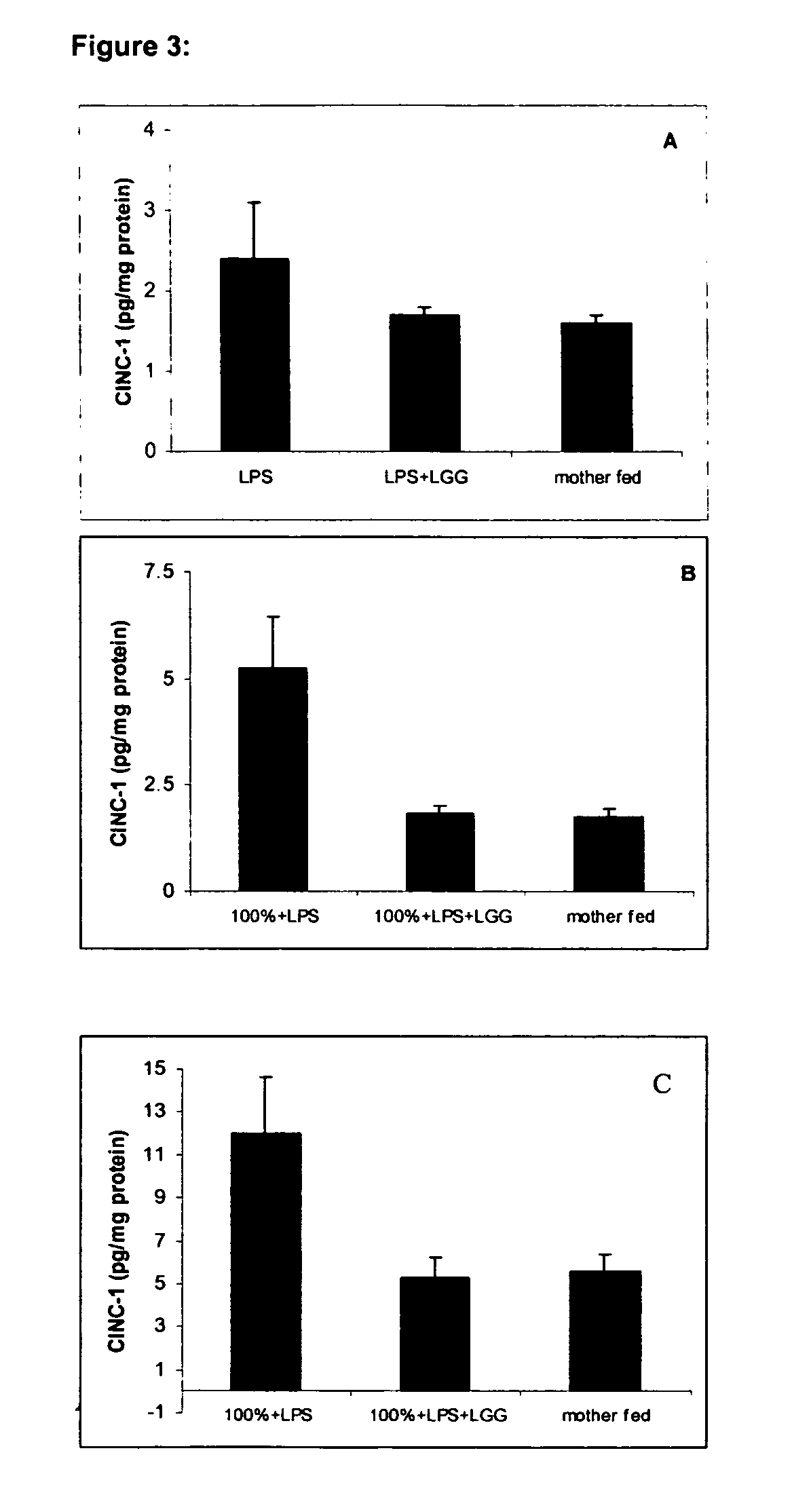Method for treating or preventing systemic inflammation in formula-fed infants
a systemic inflammation and formula technology, applied in the field of formula fed infants systemic inflammation treatment or prevention, can solve the problems of insufficient inflammatory response, inconvenient treatment, and damage to the immune system, and achieve the effect of preventing the spread of pathogens and promoting the growth of bacteria
- Summary
- Abstract
- Description
- Claims
- Application Information
AI Technical Summary
Benefits of technology
Problems solved by technology
Method used
Image
Examples
example 1
[0077] This example describes the materials and methods necessary to show the effect of LGG on formula-fed neonatal rat pups. In two separate experiments, ten Sprague-Dawley (Taconic, Germantown, N.Y.) infant rats were randomly assigned to two gastrostomy feeding groups with five rats per group. Gastrostomy feeding, using the rat infant “pup-in-the-cup” model, began on day 7 of life of the rat pups. The gastrostomy feeding tubes were constructed from 14-cm sections of polyethylene tubing that were inserted into the stomach of the pups. This is a commonly used model in studies of developmental nutrition when it is important to manipulate nutritional composition in the absence of maternal feedings. The gastrostomy placement was done under isoflurane anesthesia. Timer-controlled syringe pumps were connected to the feeding tubes and were set to feed the rats for the first 20 minutes of every hour at a weight-dependent flow rate. Five mother-reared rats of the same age were used as refer...
example 2
[0082] This example illustrates the effect of LGG on the growth of pups after gastrostomy feeding. The rat pups were weighed daily after the gastrostomy feeding and compared to mother-fed reference animals. FIG. 1 shows that mother-fed animals grew more rapidly than the LPS-treated, gastrostomy-fed pups. Line graphs represent the increased rate of pup body weight with the time expressed increase from the beginning of the study. Providing LGG to gastrostomy-fed, LPS treated pups did not improve weight gain.
example 3
[0083] This example illustrates the effect of LGG on the intestinal morphology of the rat pups. The microscopy studies were focused on the ileum because this is a region that is most highly susceptible to certain pathologies in infants (e.g., necrotizing enterocolitis and nonnecrotizing enterocolitis-related perforations). Formalin-fixed ileum samples were embedded in paraffin; 6μm sections were cut using a 2030 Reichert-Jung paraffin microtome. The sections were then stained with a routine hematoxylin and eosin (H&E) stain. FIG. 2 shows the results of this stain.
[0084] Sections of ileum from LPS-treated rat pups (FIGS. 2G-2I) showed a striking metaplasia in the villous epithelium, with increased clearing of the cytoplasm, compared to the mother-reared controls (FIGS. 2A-2C). FIGS. 2G-2F show that these sections also featured expansion of the lamina propria by a lymphoplasmacytic infiltrate, thinning of the muscularis mucosa, and regenerative changes in the crypts including increas...
PUM
 Login to View More
Login to View More Abstract
Description
Claims
Application Information
 Login to View More
Login to View More - R&D
- Intellectual Property
- Life Sciences
- Materials
- Tech Scout
- Unparalleled Data Quality
- Higher Quality Content
- 60% Fewer Hallucinations
Browse by: Latest US Patents, China's latest patents, Technical Efficacy Thesaurus, Application Domain, Technology Topic, Popular Technical Reports.
© 2025 PatSnap. All rights reserved.Legal|Privacy policy|Modern Slavery Act Transparency Statement|Sitemap|About US| Contact US: help@patsnap.com



